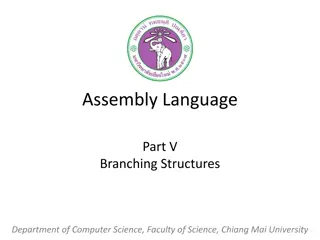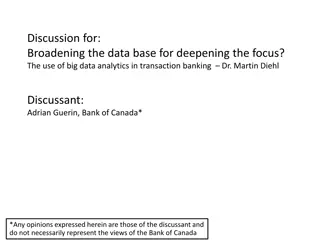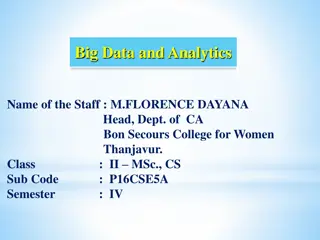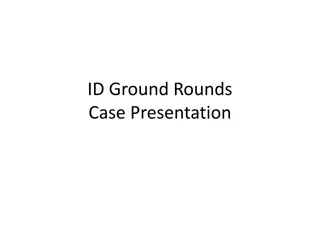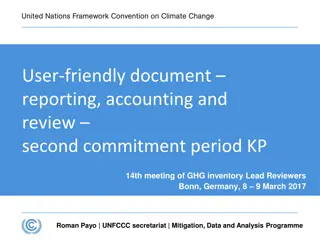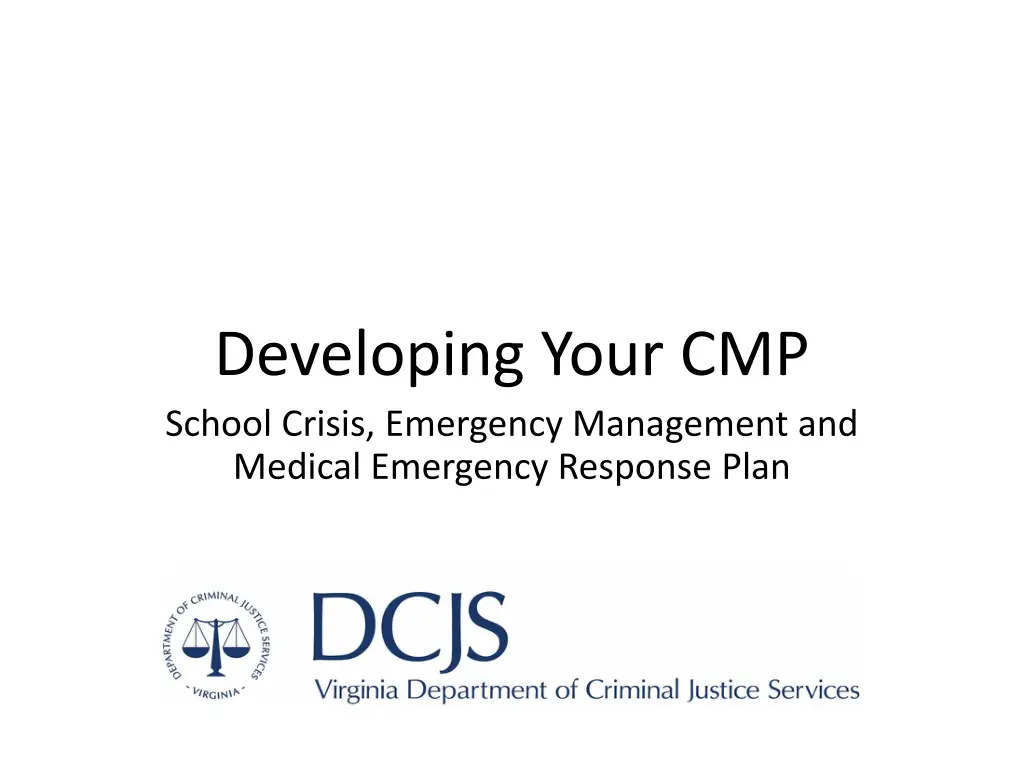
Developing Your CMP School Crisis Emergency Management Plan
Learn the crucial steps in developing your school's Crisis, Emergency Management, and Medical Emergency Response Plan. Understand the important considerations, information needed for completion, legal authority, and team requirements for effective planning and response.
Download Presentation

Please find below an Image/Link to download the presentation.
The content on the website is provided AS IS for your information and personal use only. It may not be sold, licensed, or shared on other websites without obtaining consent from the author. If you encounter any issues during the download, it is possible that the publisher has removed the file from their server.
You are allowed to download the files provided on this website for personal or commercial use, subject to the condition that they are used lawfully. All files are the property of their respective owners.
The content on the website is provided AS IS for your information and personal use only. It may not be sold, licensed, or shared on other websites without obtaining consent from the author.
E N D
Presentation Transcript
Developing Your CMP School Crisis, Emergency Management and Medical Emergency Response Plan
Unit 1: BEFORE Important Considerations Before a Crisis
Information Needed for Completion
INTRODUCTION Setting up the CMP
Outline of the CMP Aligns with nationally recognized phases of emergency management Actions needed Before, During, and After an Emergency Drafted to simplify Planning Preparation Workflow
Purpose, Goal, and Scope Plan for a rapid, coordinated, effective response Primary focus on Before actions Meant to supplement, not replace: School Safety Plan School Security Plan Division-level Violence Prevention Programs Division-level Suicide Prevention / Intervention Guidelines School or Division Behavioral Threat Assessment Procedures
The Code of Virginia: Sections to Know 22.1-279.8: Requires every school have a plan Responsibilities for School Board Responsibilities for Superintendent 22.1-137.3: Requires School Board to provide training for all staff and students annually on safety procedures 22.1-137 and 22.1-184: Details required drills to be completed each school year
Plan Development and Maintenance
Planning Team Required to work with: Chief Law Enforcement Officer Fire Chief Chief of EMS Agency Executive Director of Regional EMS Council Emergency Management Official Health Department Official Aligns with local, regional, state, and federal plans
Contact Lists Administrators Safety Team School ICS Team
Record of Updates and Revisions Updates can be made as needed Personnel change Resources available Local policy references Revisions should be made before annual review Legal / legislative requirements Change in protocols based on exercise or drill Emergency that reveals deficiencies or shortfalls Annually plan must be reviewed by the school board Superintendent must certify review to VCSCS
Plan Distribution Should be treated as confidential Distribution is limited by school board Previous versions should be destroyed when updated
Plan Distribution Division Level: Full copy Superintendent, Board, Principal Responding Agencies School Level: Full copy to Division leadership and responding agencies Abbreviated copy to staff and faculty Applicable sections to Relocation sites, MOU agencies
Module 1 Prevention/Mitigation, Protection, and Preparedness Strategies
Prevention Actions taken to avoid an incident or to intervene to stop an incident from occurring May include: Vulnerability assessments and corrections School climate and culture surveys Establishing communications procedures Policies related to building access Systems for student and staff accountability
Mitigation Sustained activities to reduce the loss of life and property by avoiding or lessening the impact of an unavoidable disaster May include: Fencing hazardous areas Anchoring outdoor equipment that could become flying projectiles in high winds Bolting bookshelves to walls and securing loose wires
Protection Actions taken to safeguard all students, staff, assets, and critical infrastructure elements against threats and hazards May include: Monitoring information related to physical or cyber threats Delaying, diverting, and halting perceived threats Using technological and cyber measures to control access to critical locations and systems
Preparedness Actions to ensure that all stakeholders can respond in a rapid, coordinated, and effective manner to help save lives and minimize damage May include: Establishing Incident Command System Preparing emergency supplies and equipment Designating response areas of the facility Implementing drills, trainings, and exercises with fidelity that include students, staff, and first responders
Safety Team / Committee Membership Varying perspectives Knowledge of facility-specific needs Roles / Responsibilities Oversee safety for building Provide feedback on plan, drills, exercise, etc. Suggested additional training Incident Command System Delivery of Critical Incident Response curriculum Behavioral Threat Assessment overview training
Readiness Levels Describe varying levels of activities Align with local, regional levels Level 1: Normal Operations Level 2: Increased Awareness Level 3: Increased Readiness Level 4: Escalated Level 5: Emergency
Hazard Analysis Completing the Hazard Analysis Varying sources of data Use to guide response actions Use to guide drill / exercise development Continued risk assessment State Audit process / Safety Inspection Checklist
Types of Hazard Natural Hazards Technological Hazards Biological Hazards Adversarial, Incidental, Human-Caused Threats Facility-Specific Hazards
Risk Identification Safety Assessment State Audit Process Behavioral Threat Assessment Anonymous Reporting
Daily Safety Operations Access Control Visitor Management Physical safety features Limiting access by using gates, fences, etc. Monitoring / surveillance systems
Daily Safety Operations Identification badges: staff, visitors, students After-hours / weekend access Substitute Teachers Auxiliary / Portable buildings
Module 2 Planning and Practicing
Emergency Drills Type and Frequency Scheduling drills Documenting drills
Emergency Drills Know the Code of Virginia: 22.1-137, 8VAC20-70-110 Type and Frequency Legislatively Mandated Fire Lockdown Tornado Bus emergency exit Recommended Earthquake Secure Shelter
Emergency Drills Scheduling drills Varying days and times Inconvenient times Test certain areas of building (cafeteria, gym, etc.) Documenting drills Maintain documents according to division records policy Sample forms in Supporting Documents Safety Team should complete After-Action Review
Emergency Drills Conducting Trauma-Informed drills Other types of practice: Tabletop exercise Functional exercise Full-Scale exercise
Emergency Supplies and Equipment Mapping Fire Safety Mobility Aides Emergency Notification Medical Response Eye wash / shower pulls
Emergency Supplies and Equipment Building specific: Responding agencies Contact information Go Kit locations and contents
Medical Emergencies Traumatic Injury Response training Control the Bleed Crisis Response and Critical Care CPR / AED / First Aid Specialty Staff Trainings
Individual Safety Plan (ISP) Exist for individuals with additional needs Functional needs: mobility assistance, deaf / hard of hearing, or blind Access needs: use of ramps or elevators instead of stairs Language needs: Second language learners Cognitive needs: inability to respond independently Medical needs: startle seizures, ancillary equipment Document ISP Listed in Crisis Management Plan with assigned staff member
Functional and Access Needs May be permanent Identified physical disability Physician diagnosed May be temporary Surgical procedure Temporary Injury
Assignments During a Crisis Individuals who need additional help are listed in CMP Staff assigned will be trained on how to best assist Back-up staff may be trained on multiple individuals
Developing the ISP TEAMS concept Transportation Emotional/Mental/Behavioral Health Auxiliary Communication Medical Health Security and Supervision
Documenting the ISP Include with IEP or Section 504 paperwork Individuals with temporary needs Crisis Management Plan Assigned staff members





